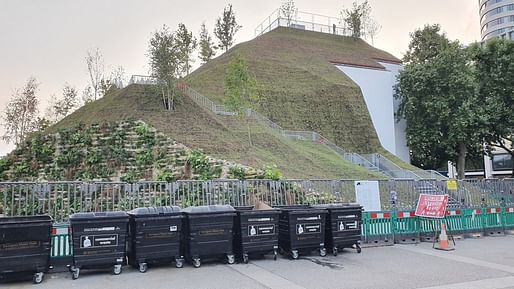

MVRDV’s latest project is closing after just two days following a torrent of public backlash against the $3 million artificial earthen mound in Westminster, London.
The Marble Arch Mound opened earlier this week after an abbreviated construction period which began in early May. Commentators online were quick to point out the rather stark contrast between the project’s renderings at announcement and actual appearance upon delivery. Swaths of an exposed scaffolding base, an incomplete application of greenery, and a confounding maze of fences have left people to question the project’s cost, utility, and even meaning. Westminster City Council, the park’s operator, has apologized for the mishap in an unprecedented statement admitting to the mound’s “not ready” status and closing it to the public as a result.
Refunds are now being provided to the disheartened customers who were able to visit the structure following its opening on Monday. In addition to the £8 ($11) fee, they were given free passes for future visits and encouraged to return once the installation “had time to bed in and grow,” according to The Guardian.
The temporary park was commissioned by Westminster City Council as part of a post-covid revitalization effort aimed at the busy Oxford Street shopping area adjacent to the well-known 19th-century Marble Arch. Its simple program guides users up one side of the hill and back down again through an internal staircase that also serves as an exhibition hall. The principal selling point being the “striking views” of Hyde Park and the rest of London offered to the 200,000 anticipated annual visitors of the 82-foot-tall attraction.
“We originally wanted the hill to totally cover the arch,” MVRDV founder Winy Maas told Guardian critic Oliver Wainwright shortly after the project’s February announcement. The firm has thus far echoed the city council’s sentiment about the park’s preparedness, also citing the weather's effects on its sedum (which had to be used in place of natural soil owing to the slope) among other factors that have contributed to the less-than-optimal appearance of the green space. A spokesperson for MVRDV told the Architect's Journal Wednesday that the installation was meant to be seasonally responsive, pleading for critics to “give nature time” before passing a definitive judgment on the project.
Public green spaces like the mound and New York’s new Little Island Park have been in vogue in an era when urban planning increasingly combines sustainability motifs with interactive public spaces to form instagrammable destinations that are too easily marketed as eye-catching development projects with exclusively positive economic and environmental benefits. Maas in particular is a champion of the phenomena he refers to as the Green Dip. The response of Londoners now has the chance to set a precedent for similar projects and planning writ large.
The mound itself will be dismantled and repurposed in January. The New York Times has more on the public’s response here.
No Comments
Block this user
Are you sure you want to block this user and hide all related comments throughout the site?
Archinect
This is your first comment on Archinect. Your comment will be visible once approved.